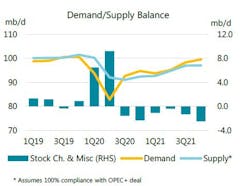IEA revised up 2021 global oil demand growth forecast
In its latest Monthly Oil Market Report, the International Energy Agency (IEA) revised up its 2021 global oil demand growth forecast by 230,000 b/d. Following a decline of 8.7 million b/d last year, world oil demand is now expected to expand by 5.7 million b/d in 2021 to 96.7 million b/d.
The upward revision was backed by improved macroeconomic outlook, along with stronger prompt indicators. In its April update of the World Economic Outlook, the IMF raised its forecasts for 2021 and 2022 global GDP growth to +6% and +4.4%, respectively, but noted divergent recoveries and a high degree of uncertainty. Not surprisingly, the biggest upgrade was for the US, given its swift vaccine rollout and hefty stimulus packages on the way. China was also revised slightly higher.
There are still lingering concerns over the strength of the recovery in demand growth, however, with the number of COVID-19 cases surging in Europe and some major oil consuming countries such as India and Brazil.
World oil supply rose 1.7 million b/d in March to 92.9 million b/d after shut-in US output recovered from a cold snap. Further gains from the US, Brazil, and biofuels are set to lift global supply in April, while producers taking part in OPEC+ cuts continue to limit flows. According to IEA forecasts, non-OPEC+ will see gains of 610,000 b/d in 2021 after a 1.3 million b/d drop in 2020. US supply is set to fall 100,000 b/d after a 600,000 b/d loss in 2020.
Preliminary data suggest OECD oil stocks held largely steady in March, following seven consecutive months of draws. In February, OECD oil inventories fell by 55.8 million bbl, or 2 million b/d. At 2,977 million bbl, total oil stocks were 28 million bbl above the 2016-2020 average, but 94 million bbl higher than a year ago.
Crude oil benchmarks retreated from their 22-month highs of mid-March, with Brent and WTI last trading at around $63/bbl and $60/bbl, respectively.
“Prices could yet come under renewed pressure in the coming months with world oil supply set to ramp up and shift the market from deficit towards balance. Global production was already on the rise in March, increasing by 1.7 million b/d as US output recovered from a sharp drop in February and OPEC+ supply edged higher. Iran has been opening up the taps since late last year, defying US sanctions, with its crude production now at the highest in nearly two years. More oil is on the way after OPEC+ ministers agreed on 1 April to gradually ease output cuts by more than 2 million b/d from May through July,” IEA said.
According to IEA, the market changes dramatically in the latter half of this year as nearly 2 million b/d of extra supply may be required to meet expected demand growth—even after factoring in the announced ramp-up of OPEC+ production. Global refinery runs are forecast to rise by 6.8 million b/d from April to August, just as crude oil-fired power generation rises seasonally.
“Yet, the market does not face an impending supply crunch. By July, OPEC+ will still have close to 6 million b/d of effective spare production capacity, excluding some 1.5 million b/d of Iranian crude now shut in by sanctions. The bloc’s monthly calibration of supply may give it the flexibility to meet incremental demand by ramping up swiftly or adjusting output lower should the demand recovery fail to keep pace,” IEA said.
